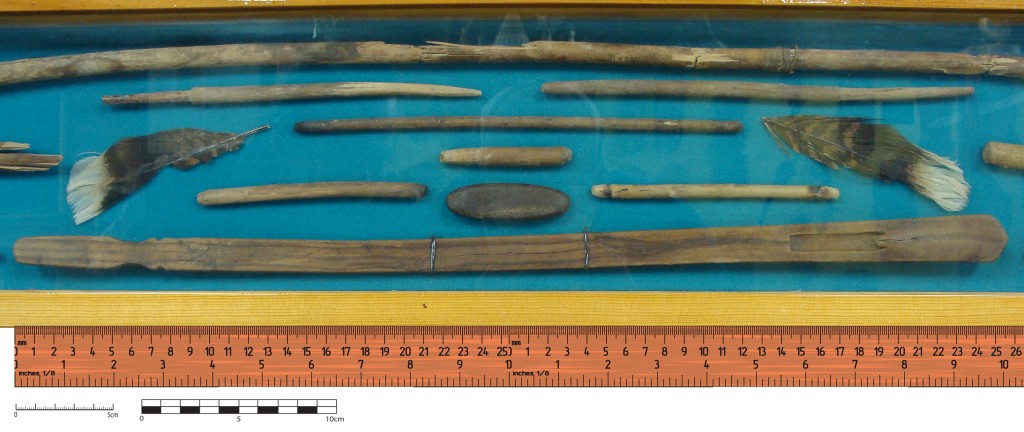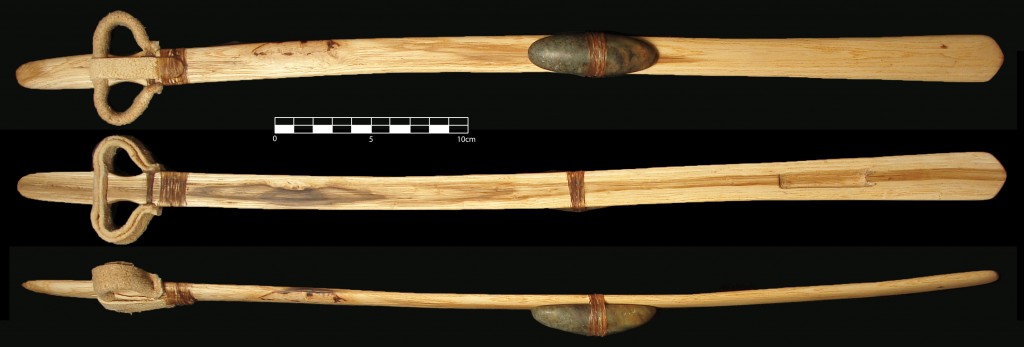Devin Pettigrew
4/26/2012
The Artifact
In late March, 2012 we visited Huck’s Museum in Blanding, Utah in order to get a look at a truncated handle form Basketmaker atlatl. Although Huck has no provenience on the atlatl, which was given to him by a young man at an unknown time, our best guess is that it hails from the Four Corners area due to similarities in form with local atlatl artifacts, and the fact that much of Huck’s relics were collected from the area.
Figure 1. Scaled image of the Huck Atlatl.
The artifact is missing loops and other accoutrements, but is otherwise very well preserved. Some staining can be seen at the finger notches and on the lower handle, with a lighter area in between suggesting the lower placement of the loops. Otherwise the artifact has aged evenly and its difficult to determine whether a weight or fetish was attached to the shaft. A view of the underside should be made to look for pitch indicating weight attachment. Huck claimed the weight shown just above the atlatl did not belong to it, though without further reasoning, and it seemed impolite to press for details.
The following measurements were made by taking an overall length of the atlatl through the display case and scaling the image to that measurement. As such the measurements aren’t exact, but pretty close. Luckily the display case was shallow and the atlatl is set close to the glass.
Huck Atlatl Dimensions:
Mainshaft
length: overall 20-1/8”
of working lever 14-1/2”
from spur tip to distal end 2-3/4”
width: average top of loops to midpoint 11/16”
at start of trough 3/4”
at spur 7/8”
at distal end 1”
Lower handle
length: 1-7/8”
width: 11/16″
Finger notches
length: 7/8”
width: ½”
Trough
length: to spur tip 1-3/4”
width: tapers from 5/16” proximally to 3/8” distally
Replication
Figure 2. Replica of the Huck Atlatl in gambel oak.
The Huck atlatl is very likely made of gambel oak (Quercus gambelii) as are a majority of Basketmaker atlatl artifacts. The slight side-to-side curvature of the shaft may be due to warping, though it could also represent the natural shape of the limb.
At the lower end of the finger notches is a wide strip of lighter wood from the lower placement of the loops. However one set of “lugs”, or retention notches above the finger notches most likely indicates one attachment point for the finger loops. On Basketmaker atlatls with surviving loops this attachment method is typically used with a retention method for the bottom of the loops. In this case I’ve used the White Dog Cave loop attachment method, with a retention strap.
Figure 3. The Huck atlatl with hypothetical loop and weight attachments.
The weight I’ve made for this replica is based off of the dimensions for the atlatl weight set just above the atlatl in the display case (7/8″ wide by 2-1/2″ long; height can’t be determined). Although Huck claimed that the weight doesn’t belong with the atlatl, the width of the weight perfectly matches the atlatl shaft and is a nice match for it. A band of slightly lighter wood located under the distal wire which holds the artifact in the case may represent the placement of a former sinew wrapping for a weight. However this is just a guess, and its possible the atlatl didn’t have a weight attached.
Figure 4. Gripping a dart with the Huck Atlatl.
This atlatl has most in common with the Broken Roof Cave atlatl, which also has a weight attached at a similar position, a lengthy head space above the spur, and a truncated or “vestigial” handle. This replica of the atlatl functions well with darts of a slightly smaller caliber than those recovered at White Dog Cave.






Justin/Devin is the bend on the atlatl warped or steam bent?
Ethan,
Sorry for the long reply. If you’re referring to the horizontal curvature, that’s likely warping or else just a relic of the way the wood grew which the crafter didn’t feel necessary to correct for. If you’re referring to the vertical curvature, that’s intentional. Whether it was steamed into that shape or just happened to grow that way for the crafter to take advantage of, there isn’t really a way of knowing.
-Justin
Hello Justin and Devin,
I am curious about the lengthy head space above the spur. I have found that leaving too much extra length there on atlatls with a hammer-style grip will cause a clicking sound during throwing as the dart disengages from the spur, but then gets tapped by the distal end of the atlatl a fraction of a second later. Have you had this problem when using this atlatl replica, or is there a difference in the throwing technique or perhaps release time that avoids this problem?
Thanks!
Ryan,
Thanks for writing. Some of these Basketmakers have really long headspace-the Kinboko Canyon atlatl is a good example of this. With the dart properly balanced and spined, and with good throwing form, you won’t have this issue. Sometimes with these longer headspaces you wind up with a sliding effect, where the dart butt slides along the headspace in the release, but as far as I can tell that doesn’t seem to have any effect on performance (Speed, accuracy, whathaveyou).
-Justin
In addition to what Justin said, I have also noticed that willow darts make less sound or will not click at all when river cane darts will. The latter is likely louder because it is harder (different composition creates different acoustic variables), and will click when willow doesn’t due to different spine characteristics. Willow was traditionally paired with the known basketmaker systems in the Southwest, so these effects may have been noticed but weren’t a functional barrier to this aspect of style.
In general, the extended head space can get in the way unless the system is designed properly, and from what we’ve seen they were certainly considerate of this. I will be posting an article on atlatl flexibility soon to discuss this further.